engine CHEVROLET TRACKER 1998 1.G Owners Manual
[x] Cancel search | Manufacturer: CHEVROLET, Model Year: 1998, Model line: TRACKER, Model: CHEVROLET TRACKER 1998 1.GPages: 386, PDF Size: 21.17 MB
Page 231 of 386
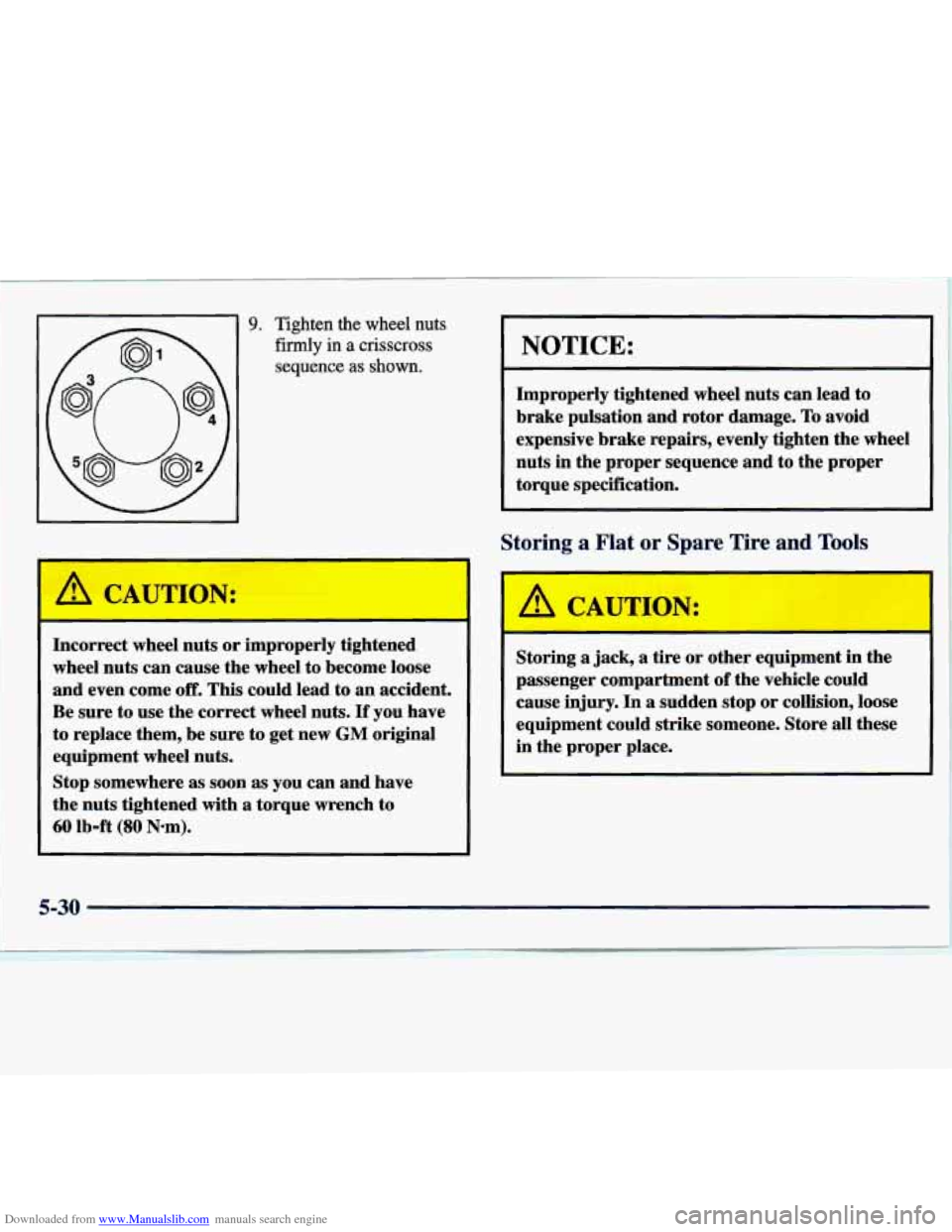
Downloaded from www.Manualslib.com manuals search engine 9. Tighten the wheel nuts
firmly in a crisscross
sequence as shown.
- a CAUTION:
NOTICE:
I'
Improperly tightened wheel nuts can lead to
brake pulsation and rotor damage. To avoid
expensive brake repairs, evenly tighten the wheel
nuts in the proper sequence and to the proper
torque specification.
I
-- I-
Incorrect wheel nuts or improperly tightened
wheel nuts can cause the wheel to become loose
and even come
off. This could lead to an accident.
Be sure to use the correct wheel nuts.
If you have
to replace them, be sure to get new
GM original
equipment wheel nuts.
Stop somewhere as soon
as you can and have
the nuts tightened with
a torque wrench to
60 lb-ft (80 Nom).
a CAUTION:
Storing a jack, a tire or other equipment in the
passenger compartment of the vehicle could
cause injury. In
a sudden stop or collision, loose
equipment could strike someone. Store all these
in the proper place.
I
5-30
Page 232 of 386
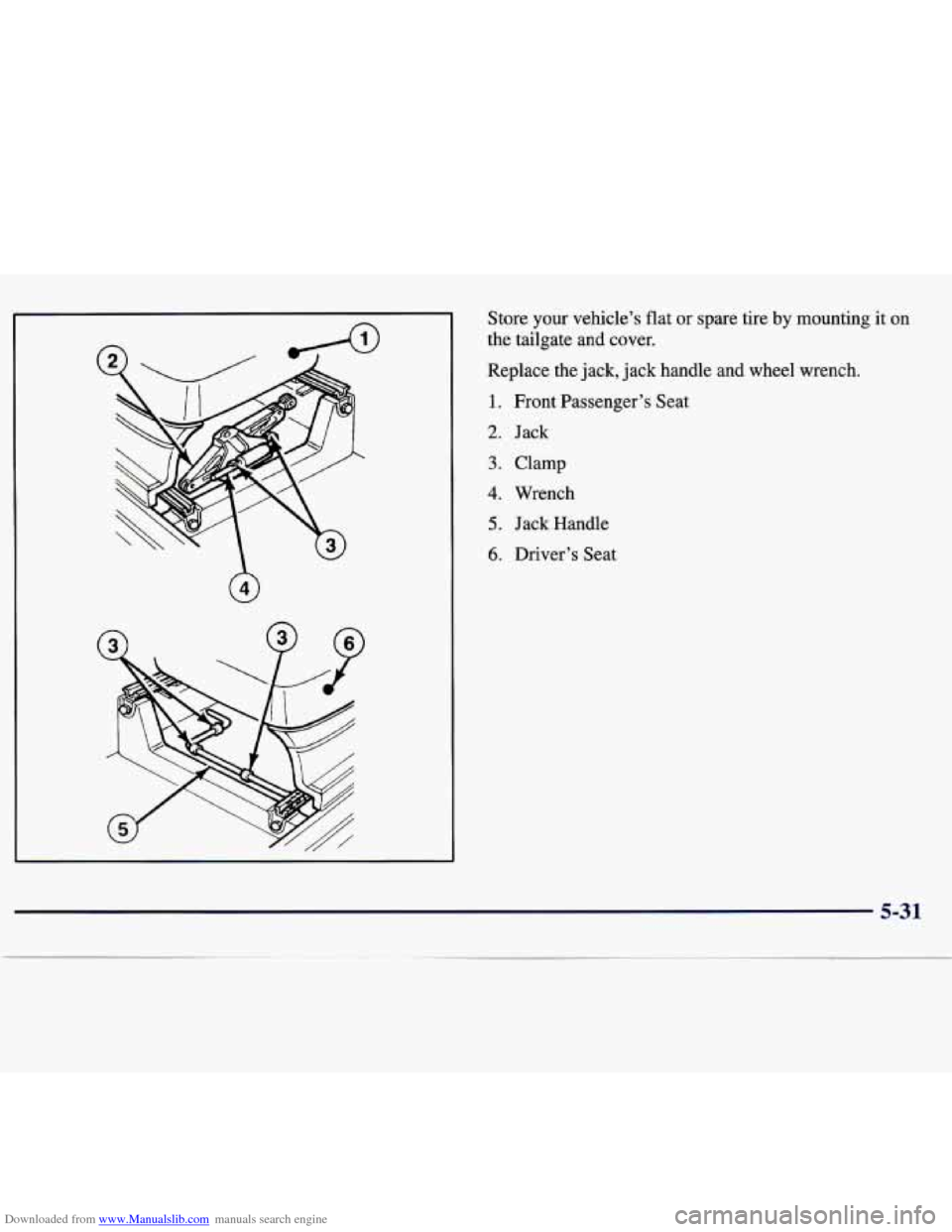
Downloaded from www.Manualslib.com manuals search engine Store your vehicle’s flat or spare tire by mounting it on
the tailgate and cover.
Replace the jack, jack handle and wheel wrench.
1. Front Passenger’s Seat
2. Jack
3. Clamp
4. Wrench
5. Jack Handle
6. Driver’s Seat
5-31
Page 233 of 386
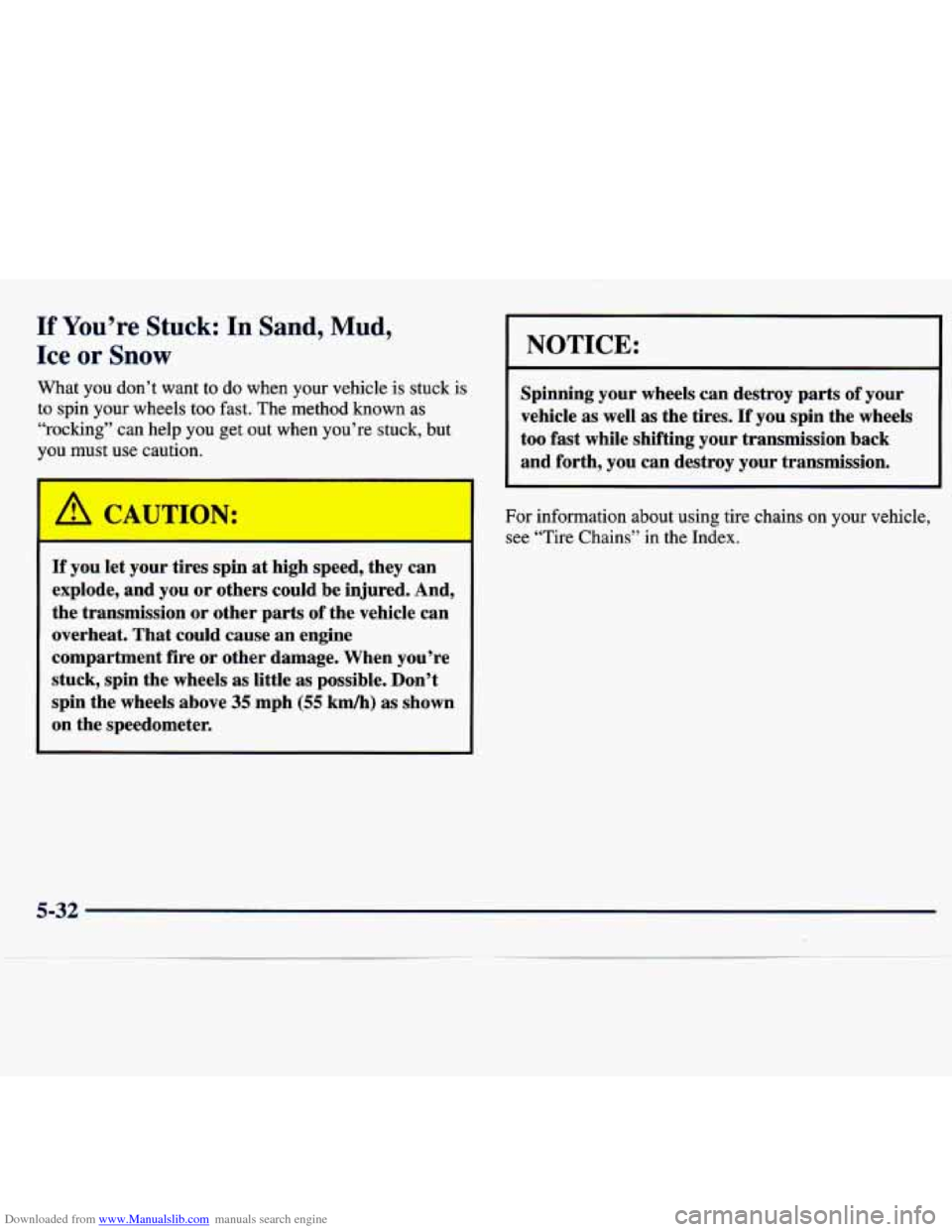
Downloaded from www.Manualslib.com manuals search engine If You’re Stuck: In Sand, Mud,
Ice or Snow
What you don’t want to do when your vehicle is stuck is
to spin your wheels too fast. The method known as
“rocking” can help you get out when you’re stuck, but \
you must use caution.
If you let your tires spin
at high speed, they can
explode, and you
or others could be injured. And,
the transmission or other parts of the vehicle can
overheat. That could cause an engine
compartment fire or other damage. When you’re
stuck, spin the wheels as little as possible. Don’t
spin the wheels above
35 mph (55 km/h) as shown
on the speedometer.
NOTICE:
Spinning your wheels can destroy parts of your
vehicle as well as the tires.
If you spin the wheels
too fast while shifting your transmission back
and forth, you can destroy your transmission.
For information about using tire chains on your vehicle,
see “Tire Chains” in the Index.
5-32
Page 234 of 386
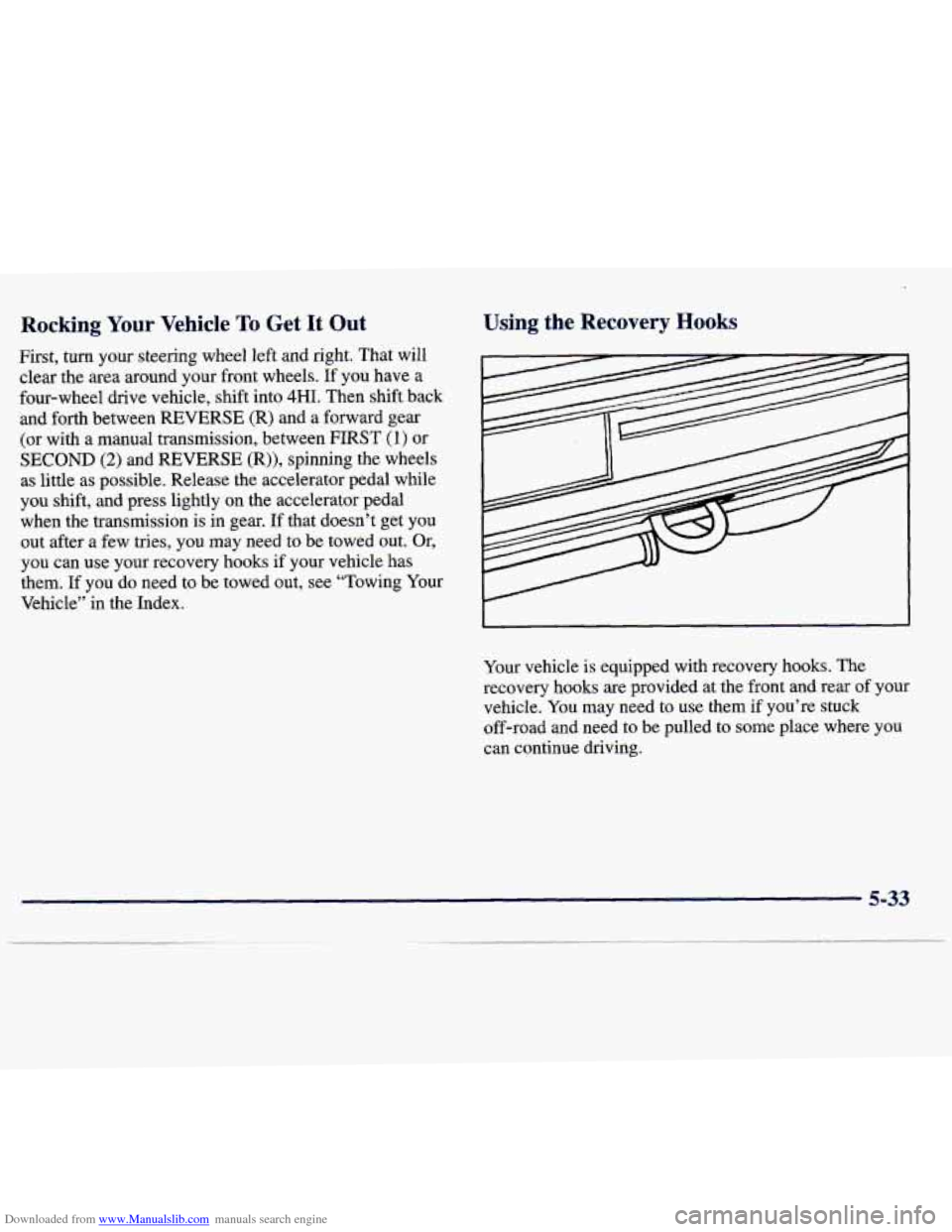
Downloaded from www.Manualslib.com manuals search engine Rocking Your Vehicle To Get It Out Using the Recovery Hooks
First, turn your steering wheel left and right. That will
clear the area around your front wheels.
If you have a
four-wheel drive vehicle, shift into 4HI. Then shift back
and forth between
REVERSE (R) and a forward gear
(or with a manual transmission, between
FIRST (1) or
SECOND (2) and REVERSE (R)), spinning the wheels
as little as possible. Release the accelerator pedal while
you shift, and press lightly on the accelerator pedal
when the transmission
is in gear. If that doesn’t get you
out after
a few tries, you may need to be towed out. Or,
you can use your recovery hooks
if your vehicle has
them.
If you do need to be towed out, see “Towing Your
Vehicle”
in the Index.
Your vehicle
is equipped with recovery hooks. The
recovery hooks are provided at the front and rear of your
vehicle. You
may need to use them if you’re stuck
off-road and need to
be pulled to some place where you
can continue driving.
Page 235 of 386
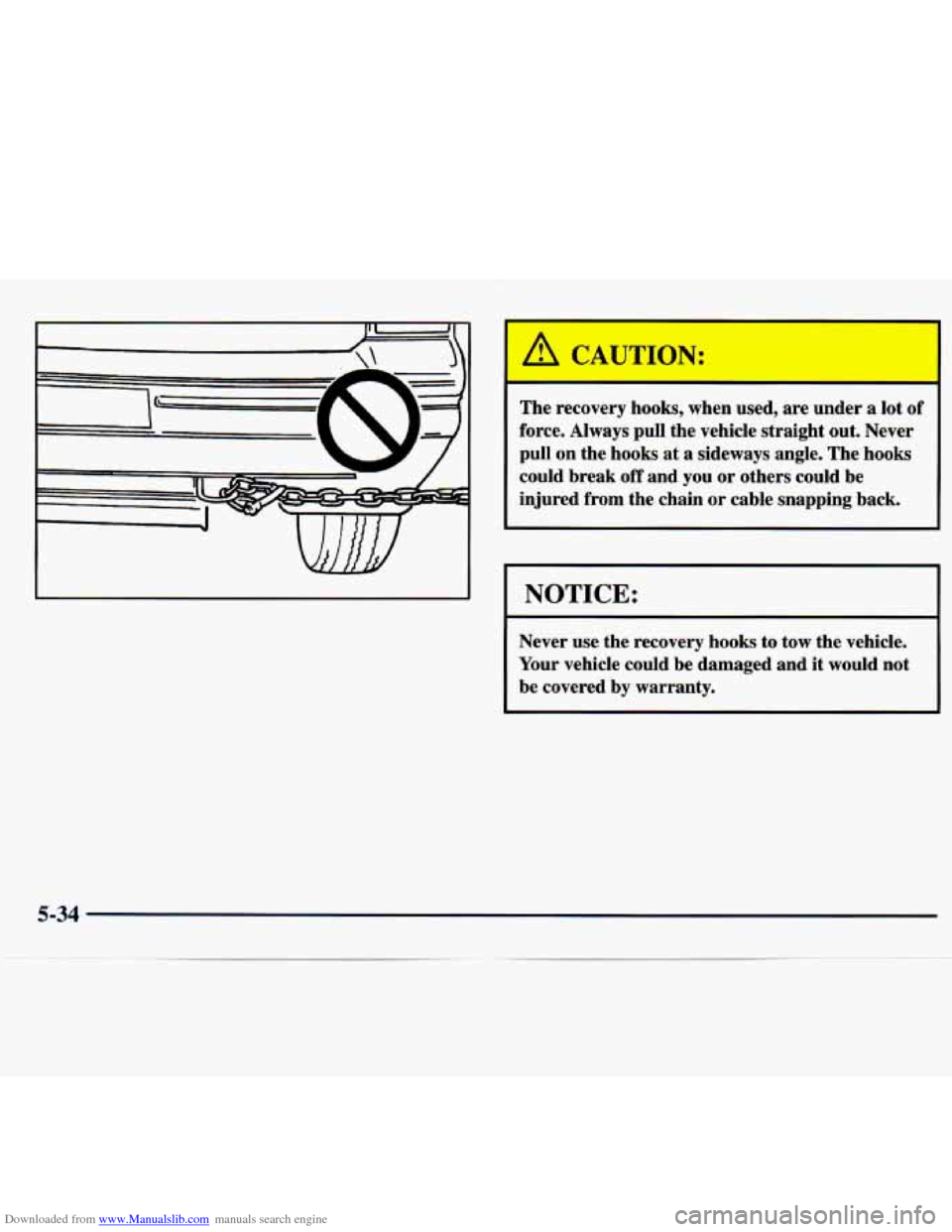
Downloaded from www.Manualslib.com manuals search engine I
I
I A CAUTION:
r
The recovery hooks, when used, are under a lot of
force. Always pull the vehicle straight out. Never
pull on the hooks
at a sideways angle. The hooks
could break
off and you or others could be
injured from the chain
or cable snapping back.
.
NOTICE:
Never use the recovery hooks to tow the vehicle.
Your vehicle could be damaged and it would not
be covered by warranty.
5-34
Page 236 of 386

Downloaded from www.Manualslib.com manuals search engine b% NOTES
5-35
Page 237 of 386
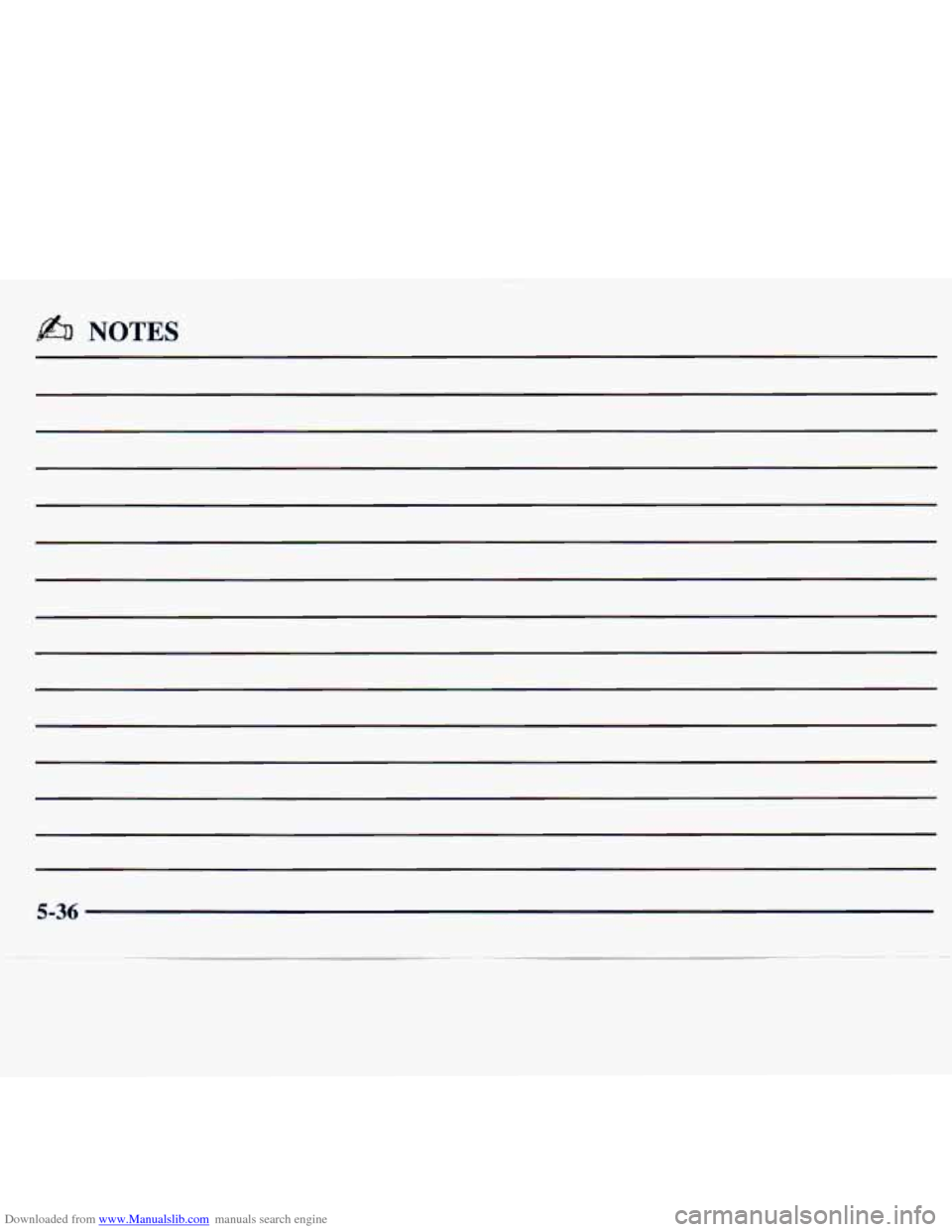
Downloaded from www.Manualslib.com manuals search engine b NOTES
5-36
Page 238 of 386
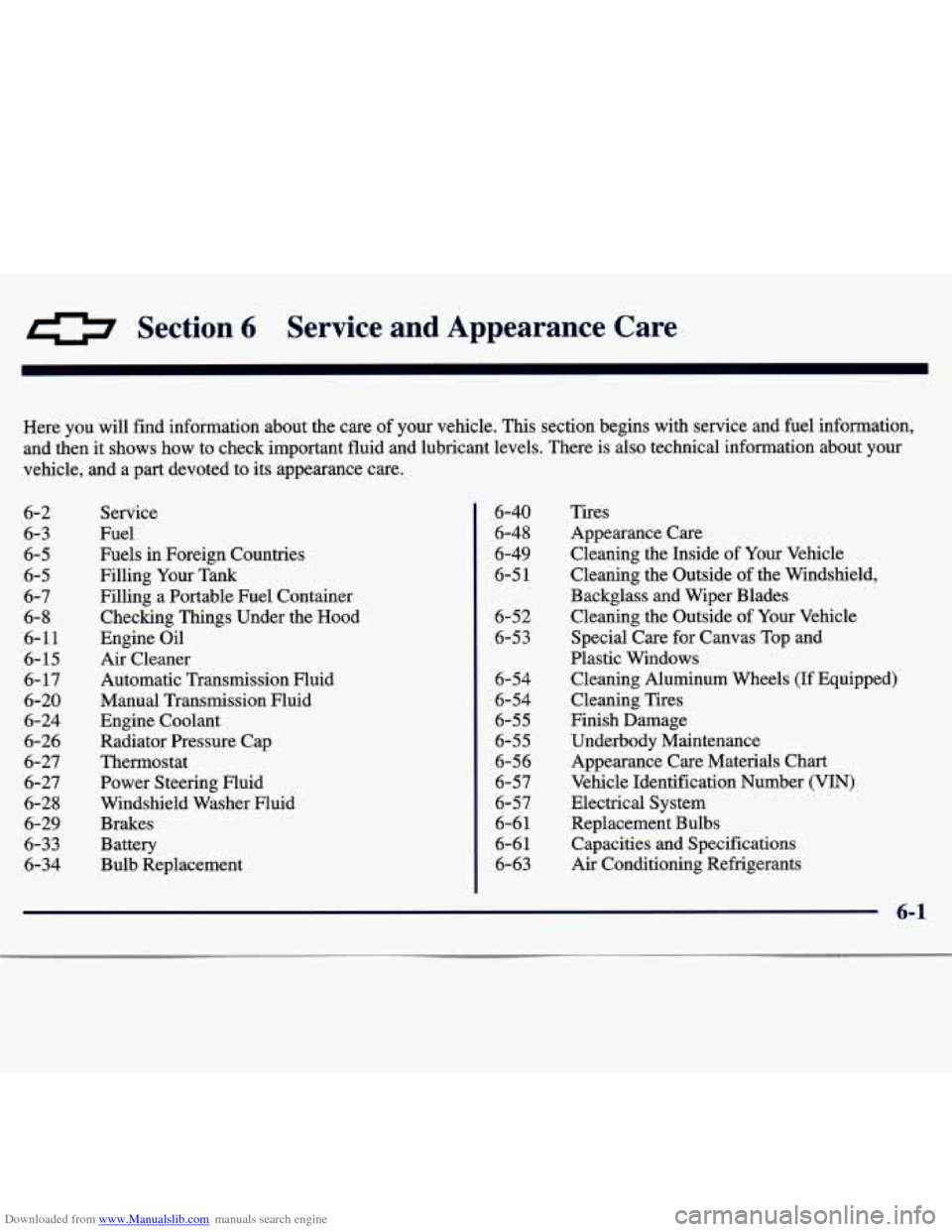
Downloaded from www.Manualslib.com manuals search engine 0 Section 6 Service and Appearance Care
Here you will find information about the care of your vehicle. This section begins with service and fuel information,
and then it shows how to check important fluid and lubricant levels. There is also technical i\
nformation about your
vehicle, and a part devoted to its appearance care.
6-2
6-3
6-5
6-5
6-7
6- 8 6-11
6-15
6-17
6-20
6-24
6-26
6-27
6-27
6-28
6-29
6-33
6-34 Service
Fuel
Fuels in Foreign Countries
Filling Your Tank
Filling a Portable Fuel Container
Checking Things Under the Hood
Engine Oil
Air Cleaner
Automatic Transmission Fluid
Manual Transmission Fluid
Engine Coolant
Radiator Pressure Cap
Thermostat
Power Steering Fluid
Windshield Washer Fluid Brakes
Battery
Bulb Replacement 6-40
6-48
6-49
6-5
1
6-52
6-53
6-54
6-54
6-55
6-55
6-56 6-57
6-57
6-61
6-6
1
6-63 Tires
Appearance Care Cleaning the Inside of Your Vehicle
Cleaning the Outside
of the Windshield,
Backglass and Wiper Blades
Cleaning the Outside of Your Vehicle
Special Care for Canvas Top and
Plastic Windows
Cleaning Aluminum Wheels
(If Equipped)
Cleaning Tires
Finish Damage
Underbody Maintenance
Appearance Care Materials Chart
Vehicle Identification Number (VIN)
Electrical System Replacement Bulbs
Capacities and Specifications
Air Conditioning Refrigerants
6-1
Page 239 of 386

Downloaded from www.Manualslib.com manuals search engine Service
Your dealer knows your vehicle best and wants you to
be happy with it. We hope you’ll go to your dealer for
all your service needs. You’ll get genuine
GM parts and
GM-trained and supported service people.
We hope you’ll want to keep your GM vehicle all GM.
Genuine GM parts have one of these marks:
ACDeI-@
Genuine
Doing Your Own Service Work
If you want to do some of your own service work, you’ll
want to use the proper Ckvrolet Service
Manual. It tells
you much more about how
to service your vehicle than
this manual can.
To order the proper service manual, see
“Service and Owner Publications” in the Index.
Your vehicle has an air bag system. Before attempting to
do your own service work, see “Servicing Your Air
Bag-Equipped Vehicle’’ in the Index.
You should keep a record with all parts receipts and list
the mileage and the date
of any service work you
perform. See “Maintenance Record’’ in the Index.
6-2
Page 240 of 386
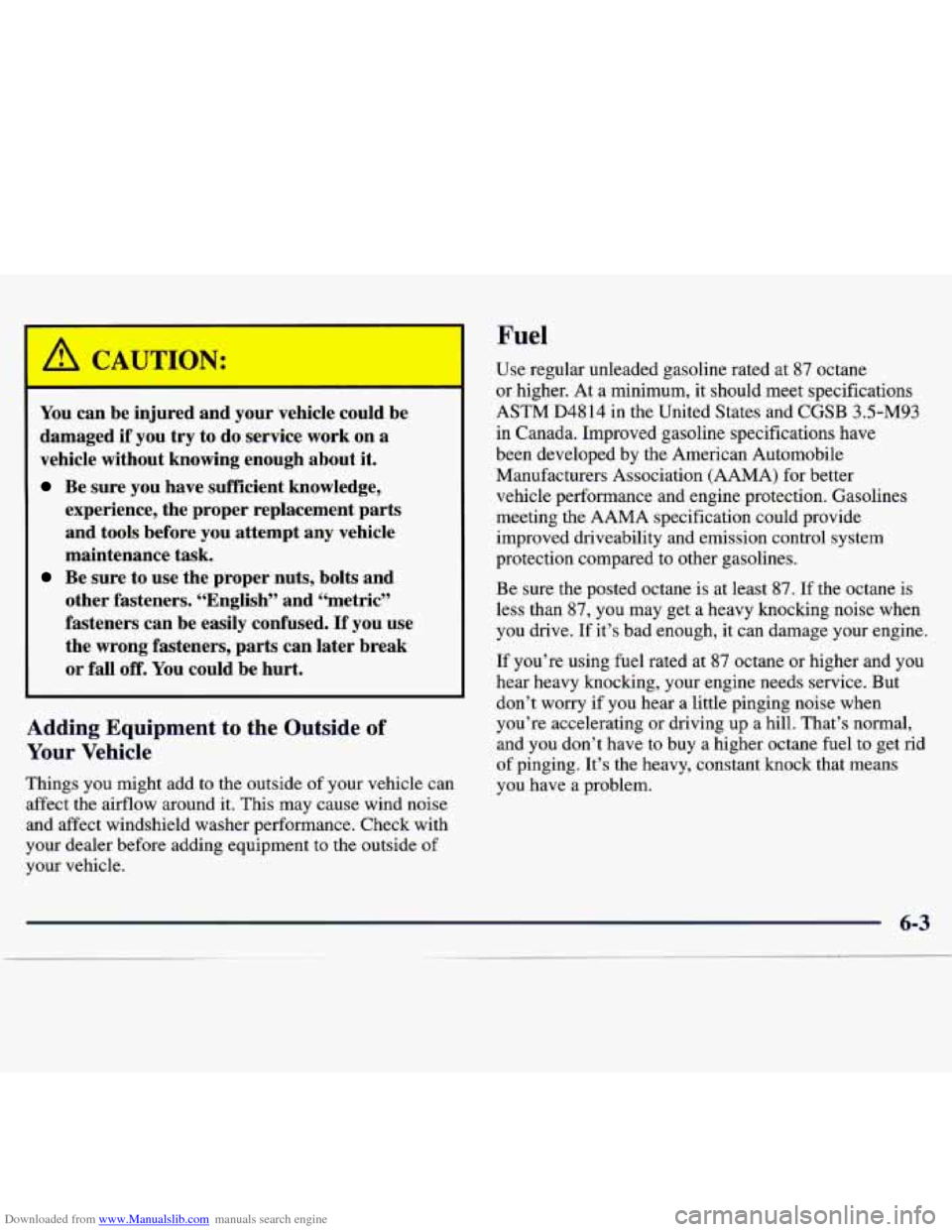
Downloaded from www.Manualslib.com manuals search engine Fuel
You can be injured and your vehicle could be
damaged if you try to do service work
on a
vehicle without knowing enough about it.
Be sure you have sufficient knowledge,
experience, the proper replacement parts
and tools before you attempt any vehicle
maintenance task.
Be sure to use the proper nuts, bolts and
other fasteners. “English” and “metric”
fasteners can be easily confused.
If you use
the wrong fasteners, parts can later break
1 or fall off. You could be hurt.
Adding Equipr- ~ I - ’; to t!- -I Out ‘de of
Your Vehicle
Things you might add to the outside of your vehicle can
affect the airflow around it.
This may cause wind noise
and affect windshield washer performance. Check with
your dealer before adding equipment to the outside of
your vehicle. Use regular unleaded gasoline rated at 87 octane
or higher. At a minimum, it should meet specifications
ASTM D4814 in
the United States and CGSB 3.5-M93
in Canada. Improved gasoline specifications have
been developed by the American Automobile Manufacturers Association (AAMA) for better
vehicle performance and engine protection. Gasolines
meeting the
AAMA specification could provide
improved driveability and emission control system
protection compared to other gasolines.
Be sure the posted octane is at least 87. If the octane is
less than 87,
you may get a heavy knocking noise when
you drive.
If it’s bad enough, it can damage your engine.
If you’re using fuel rated at 87 octane or higher and you
hear heavy knocking, your engine needs service. But don’t worry if you hear a little pinging noise when
you’re accelerating or driving up a hill. That’s normal,
and you don’t have to buy a higher octane fuel to get rid
of pinging. It’s the heavy, constant knock that means
you have a problem.